Jiaojia Archaeological Site of Zhangqiu District, Jinan Province
From:Chinese Archaeology NetWriter:Date:2018-04-11
In spring and summer of 2016 and 2017, archaeological excavations at Jiaojia site were carried out by the Department of Archaeology and museology of Shandong University. A total area of around 2,170 square meters were excavated, with a large number of artifacts uncovered, including an enclosed wall and trench, 216 tombs, 116 house remains, a pottery kiln and so on. In addition, among the 974 discovered ash pits, those belonged to the Dawenkou culture account for a large proportion , as well as some ash pits belong to the Longshan culture, Yueshi culture, and Han dynasty were found . Jiaojia site is situated in the plains at the northern side of the Tai and Yimeng Mountain Range. The site was occupied for a long time from Dawenkou culture through to the Han dynasty, while the main remains are attributed to the mid-late Dawenkou culture.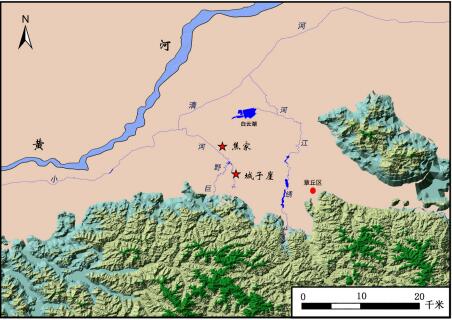
The location of jiaojia site
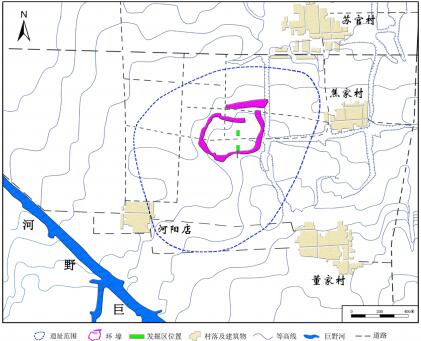
Distribution map of jiaojia site
(1) There is a clear understanding of the settlement distribution and changes through time for the excavation area. Two excavation areas – north and south, were divided by the road which ran through the site from the east to the west. At different stages of development, the settlement function of the excavation area shows a distinct difference and has experienced three major stages of development: residential period-burial period-residential period. During the burial period, the tombs were arranged in rows and columns. According to the features of the funerary objects, the cemetery was used for a long time, which is about from the late stage of the middle Dawenkou cultural period through to the late Dawenkou cultural period. In the much earlier stage of the occupation, regularly distributed semi-subterranean houses were commonly used.
(2) Remains of the enclosed walls and the trench of the late Dawenkou cultural period were uncovered. Traces of rammed earth walls were found. The trench is located outside the walls. The existing wall has a width of about 10 to 15 meters, a height of approximately 0.5 to 0.9 meters, with the thickness of each rammed layer of about 10 centimetres. The trench has a width of 25 to 30 meters and a depth of about 1.5 to 2 meters. Some tombs of the late Dawenkou cultural period directly broke the wall; therefore, the age of the wall would not be later than the late Dawenkou cultural period. These indications suggest that Jiaojia site should be the earliest walled site discovered in Haidai Region (the lower reaches of the Yellow and Huai Rivers) so far.
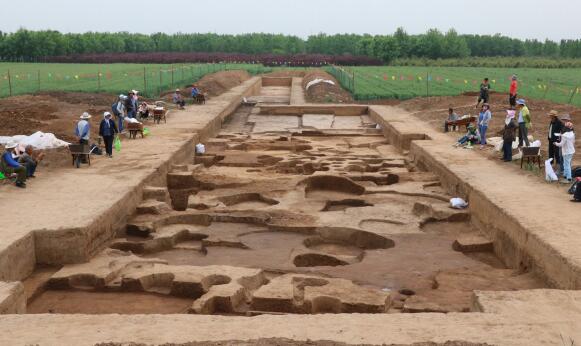
Photo shows excavation at the ruin from jiaojia site
(3) Many systematic and rich burial and sacrificial materials of the middle to late Dawenkou culture were obtained.215 tombs of Dawenkou culture were excavated, and all the tombs are earthen shaft pit tombs. Most of the tomb owners were buried in straight and face outwards. On the perspective of the burial furniture, there are two large tombs with multi-outer coffin and a single inner coffin, 20 tombs with a single outer coffin and a single inner coffin, and 113 tombs with only a single inner coffin. The utilization rate of burial furniture is up to 62.8%, which is a very rare phenomenon in comparison to other cemeteries.
The tombs were clearly differentiated by the social status of the owners. The large tombs found at present all have multi outer coffins and single inner coffin or single outer coffin and single inner coffin, the burial goods usually include jade axes, jade bracelets, carved bone cylindrical pot, ceramic cups with high handle, white pottery pitcher Gui. The quantity of medium-sized tombs is relatively large. These tombs usually contain single inner coffin. Burial goods such as ceramic tripod-Ding, ceramic pot, and ceramic cup were placed near the head and feet of the tomb owner, while small jade ornaments and shell decorations were worn by the tomb owner. The level differentiation of the tombs has been intensified from the middle Dawenkou cultural period to the late Dawenkou cultural period.
On the other hand, more than ten sacrificial pits were found concentrated distributed near the large tombs of the south excavation area, which have close relationship with the large tombs. These sacrificial pits contain either broken potteries or complete remains of a dog or an eagle. It is noteworthy that there are a few large tombs in the north excavation area were destroyed during the Dawenkou cultural period.

House remain distribution in the north area
Jade objects were recovered from104 tombs. The jade objects can be divided into two categories –sacrificial objects and decorations. Jade axe was the only sacrificial object found. Several types of jade decorations were uncovered from the site such as jade bracelets, rings, string ornaments, and earrings. It is suggested that the site was an important jade utilization centre of the Yellow River basin. On the other hand, the discoveries of phenomena such as couple-buried, tooth extraction, roe deer teeth in the hand of the dead, shells as burial goods, painted potteries as burial goods, have significantly enriched the understanding of the funeral practice and customs of the Dawenkou culture.
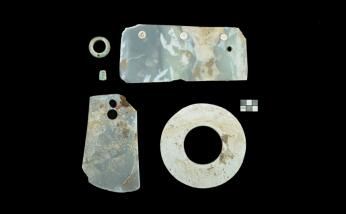
Burial jade ware in Tomb M152
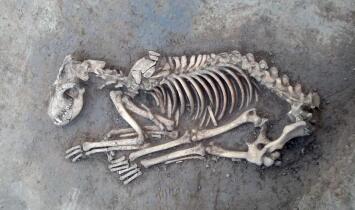
Animal burial pit in south area
(4) This archaeological excavation fills the gap in the research on the living patterns from the middle to the late Dawenkou cultural period in central and northern Shandong province. In total, 116 Dawenkou cultural house foundations have been discovered. From the perspective of periodization, most of the house remains later than the burial period were ground type, while most of the house remains earlier than the burial period were semi-subterranean type. On the perspective of the house foundation, three situations can be divided: 1 semi- subterranean houses with the functions of storage, handicraft workshops, and dwelling; 2 ground house with single room; 3 ground house with 2 rooms or 3 rooms.
Value and significance
The discovery of enclosed wall remains, trench, and a series of large tombs indicates that Jiaojia site is an important site with political, economic, and cultural significance in the North Shandong area during the middle and late stages of the Dawenkou culture. Long-term and systematically studies on the settlement archaeology and multidisciplinary investigations of the Jiaojia site have great significance and value to the exploration of the settlement structure and man-land relationship in the North Shandong region, which also could deepen the study of the origin and formation of the civilization in eastern China. (Translator: Li Xuelei Photograph:China Cultural Relics News)

